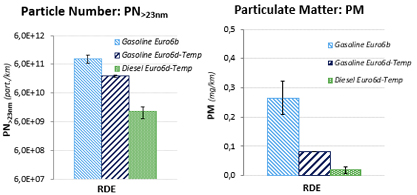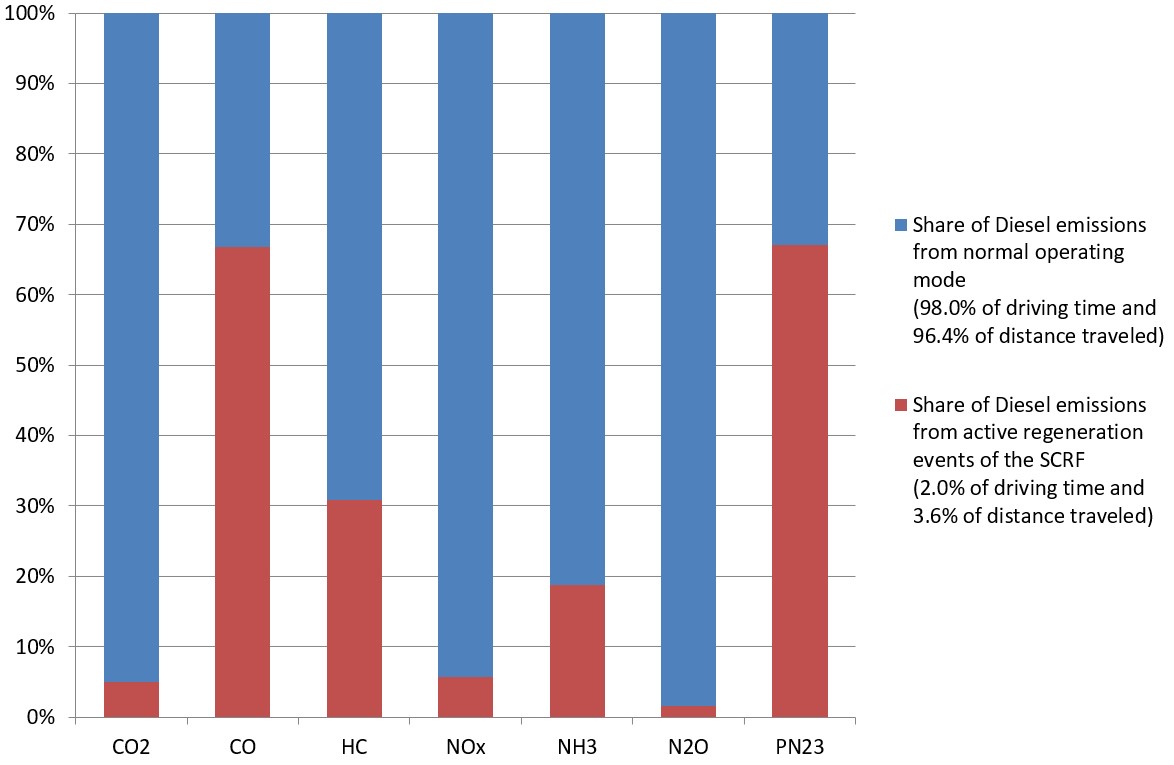03.06.2021
10 minutes of reading
The Rhapsodie project, selected within the framework of the 2017 ADEME Cortea call for projects and conducted by IFPEN in partnership with INERIS, was completed in April 2020. The objective was to evaluate gas and particle emissions - regulated or otherwise - from passenger cars of the same model – 1 diesel version equipped with an SCR on filter function and 1 gasoline version equipped with a particulate filter, both vehicles meeting Euro 6 d-TEMP standards, and 1 gasoline version without a filter, Euro 6b-accredited. The evaluations were conducted on an IFPEN rolling test bench over a cumulative distance of around 6,500 km. The impacts of different powertrains and associated exhaust gas after-treatments, start conditions (ambient/hot) and particulate filter regeneration phases were quantified. Conversely, no significant effect of the Stop & Start function on emissions was observed.
The Rhapsodie project in brief
The Rhapsodie project was conducted within the framework of the “COnnaissances, Réduction à la source et Traitement des Emissions dans l’Air” (CORTEA - Knowledge, Reduction at source and Treatment of Air Emissions) call for projects, aimed at fostering the emergence of research and development projects targeting the improvement of outside air quality, in line with ADEME’s initiatives in the energy and transport sectors.
Rhapsodie resulted in the quantification of the regulated and unregulated pollutant emissions of the most representative passenger cars in terms of sales (Euro 6), and more specifically the determination of emission factors for polycyclic aromatic hydrocarbons (PAHs) and their particulate or gaseous nitrated and oxygenated derivatives with the greatest impact on health and the environment, such as those defined by Anses (French Agency for Food, Environmental and Occupational Health and Safety) in its methodological memo on the impact of road infrastructures, and other so-called “hazardous” pollutants, including formaldehyde, acetaldehyde and ammonia. The characterization of PAHs and their derivatives was conducted by INERIS.
The tests conducted at IFPEN also delivered an in-depth analysis of emissions during the active regenerations of the SCR catalyzed particulate filter of the diesel engine. A perspective analysis taking into account the frequency of occurrence of such events over the lifetime of the vehicle was also proposed.
It should be noted that emissions respect the limits set
In several test conditions, the gasoline and diesel emissions evaluated are in line with limits set for regulated pollutants. The same is true when considering the particulate filter regenerations in the diesel powertrain (they represent 2% of the total operating time). The levels of unregulated emissions, particularly ammonia and polycyclic aromatic hydrocarbons, are highly dependent on the technology of both the engine and the after-treatment system.
In addition
> Focusing on a broad range of measured species, this study completes the one conducted by IFPEN on behalf of the French Ministry for the Ecological Transition in order to transparently define the environmental performance of existing gasoline and diesel cars (Euro 6d-Temp), the results of which were published at the end of 2020.
> The Rhapsodie 2 project, selected within the framework of the 2019 Ademe Cortea call for projects, was launched in September 2020. Emissions from a diesel powered vehicle meeting the Euro 6d-ISC (In-Service-Conformity) standard are being studied with a view to evaluating the impact of introducing different biofuel bases at various levels in a diesel fuel. Different operating conditions are reproduced on the rolling test bench and the study of the urban phase is particularly comprehensive. The results should be available by the end of 2021.
Rhapsodie Project: detailed results
-
The resources
Three compact sedans of the same model, equipped with gasoline direct injection engines with and without a particulate filter (GPF) and a diesel engine with SCR on particulate filter (SCRF) function, were selected as being representative of the current and future French car market in order to evaluate their gas and particle emissions, regulated or otherwise. The gasoline vehicle without a GPF complies with the Euro 6b standard, while the gasoline and diesel vehicles with filters comply with the Euro 6dTEMP standard.
The evaluations were conducted using an IFPEN rolling test bench over different test cycles: WLTC (Worldwide harmonized Light vehicles Test Cycles), CADC (Common Artemis Driving Cycle) and a modified version of the RDE (Real Driving Emissions) cycle. The fuels used were standard products, E10 gasoline and B7 diesel.
The emissions measured concerned particulate pollutants, regulated gaseous chemical species (CO2, HC, CO, NOx) and others that are not regulated. PAHs (polycyclic aromatic hydrocarbons) and their nitrated and oxygenated derivatives (nitro- and oxy-PAH), present in both the gas and particulate phases, were also quantified.
-
Results
It should be noted that in the results presented below and unless otherwise stated, the average pollutant emissions of the diesel vehicle take into account all of the cycles measured, including those with SCRF regeneration.
Greenhouse gas emissions
In terms of greenhouse gas emissions, during ambient-start WLTC cycles, the three vehicles emitted higher levels of CO2 than the values declared for approval (obtained during the NEDC cycle). N2O emissions showed little variation between start and operating conditions, with values of below 1 mg/km for the two gasoline versions and between 5 and 8 mg/km for diesel. For all cases, CH4 emissions accounted for less than 20% of unburned hydrocarbons, i.e., less than 5 mg/km.
Regulated pollutant gas emissions
In terms of regulated pollutant gas emissions, irrespective of cycle, CO and unburned hydrocarbon (HC) emissions were below the limits set and the diesel powertrain had the lowest emissions. The Euro 6dTEMP gasoline model had NOx emissions of less than 20 mg/km, well below the approval limit and those of the other two vehicles, whereas the diesel vehicle’s emissions were below 80 mg/km (limit set by the standard). Of these NOx emissions, NO2 emissions for the three vehicles were as high as 20 mg/km.
Unregulated pollutant gas emissionsUnregulated gas emissions were also measured. NH3 emissions for the two gasoline vehicles varied between 4 and 22 mg/km depending on the test conditions. The same emissions for the diesel model varied between 13 and 40 mg/km. SO2 emissions for the gasoline vehicles varied between 2 and 4 mg/km and appeared to be directly proportional to fuel consumption. With the diesel model, which has lower exhaust temperatures, some of the SO2 is continuously adsorbed by the catalysts and then desorbed during active SCRF regenerations; average emissions were below 2 mg/km. Formaldehyde (CH2O) emissions, below 3 mg/km, principally occurred during the first tens of seconds of ambient-start cycles. Gasoline models also emitted acetaldehyde (C2H4O), at levels of below 1 mg/km.

Particle emissions
Particle emissions were measured in terms of number (PN) and mass (PM). PM and PN≥23 (number of solid particles over 23 nm) were always below the limits set by the standards, with the two models equipped with filters (GPF or SCRF) being much lower emitters than the Euro 6b (without GPF) gasoline vehicle. Incorporating particles of between 2.5 nm and 23 nm into the count increases this total number; however its quantification is imprecise due to the higher probability for these diameters that volatile particle are taken into account with the current aerosol conditioning protocol.

Emissions in terms of particle number (PN≥23) for the diesel vehicle were higher with active SCRF regeneration, without ever exceeding the 6.1011 part./km standard limit.
PAH emissions (nitro- and oxy-PAH) varied between a few micrograms and around one hundred micrograms per kilometer, and are made up of more than 90% gas phase species. For ambient starts, PAH and gas derivative emissions for the two gasoline models were around ten times higher than those observed for the diesel version. Naphthalene was the majority compound (55-90%) for all vehicles but differences in terms of chemical profiles were observed between the vehicles.
PAH and derivative particulate emissions for the Euro6b gasoline vehicle were well above those for the Euro 6dTEMP gasoline and diesel vehicles, fitted with particulate filters. Traditional markers were found for these particulate PAHs with a predominance or chemical signature of, for the gasoline models, benzo[g,h,i]perylene, indeno[1,2,3-cd]pyrene and coronene (heavy particulate PAHs) and benzanthrone (particulate oxy-PAH), and for the diesel version, of benzofluoranthenes (particulate PAHs), 9,10-anthraquinone (oxy-PAH) and 1-nitropyrene, 2-nitro-9-fluorenone, and 2-nitrofluorene (particulate nitro-PAHs). The use of toxic equivalency factors (TEF) makes it possible to convert all PAH emissions into equivalent benzo[a]pyrene (B[a]P) concentrations: B[a]P-equivalent emissions for the two gasoline models (similar) were twice as high as those for the diesel vehicle.

No significant impact of the Stop & Start function was observed on the emissions of the vehicles evaluated. No active GPF regeneration was observed with the Euro 6dTEMP gasoline vehicle during its evaluation, continuous regeneration being the principal mode of treating filtered particles, unlike the SCRF for the diesel model. Active SCRF regenerations only represented 2% of the total operating time and 3.6% of the distance covered (43 km - four events - of the 1,206 km covered during our tests). However, these phases induced extra emissions of some pollutants, sometimes significantly so, to the point that they represented the majority of total emissions for PN≥23 and CO.







